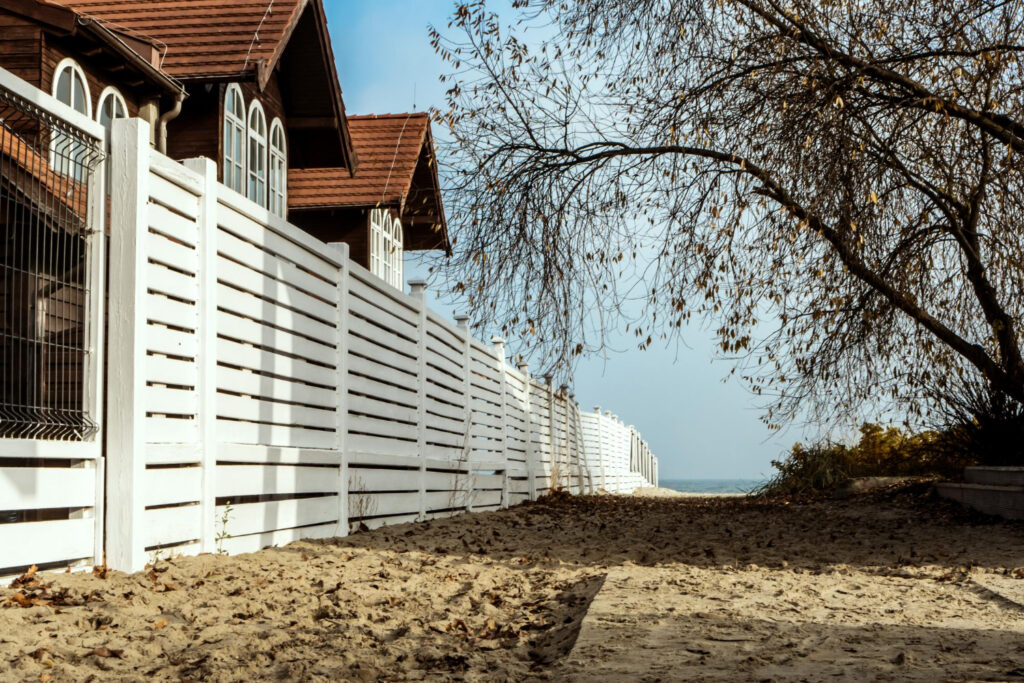What Impacts a Wood Fence’s Lifespan?
A wood fence doesn’t have a fixed expiration date. Several key factors influence how long it stands:
- Wood species & quality: Believe it or not, wood species matter in the decay and durability of your fence. If you have a choice, go for Cedar, redwood, and pressure-treated pine. These species resist decay better than cheaper softwoods. Ultimately, you get a more durable wood fence.
- Soil & drainage: If the posts are sitting in soggy soil, they will deteriorate faster. Moisture attracts microorganisms, which feed on the wood. So, good drainage is essential; it prevents water clogging or pooling. Water damage causes decay to the wood faster than anything.
- Weather exposure & climate: Imagine yourself constantly getting burned in scorching heat, and getting wet in heavy rain. It will surely break you. Just like this, humidity, rain, and sun take their toll over time. In the Bay Area, morning fog + sun cycling wears wood faster.
- Installation quality: Proper post-setting, sealing, good fasteners, and correct spacing all contribute to durability.
- Maintenance: Staining, sealing, painting, cleaning all extend life.
Given ideal conditions and upkeep, a well-built wood fence in the Bay Area can last anywhere from 20 to 35 years, sometimes more. In less ideal circumstances, you may see issues within 10–15 years.
Experience: What Homeowners Commonly See Across the Bay Area
From our years of working on outdoor spaces in the Bay Area, we’ve noticed a clear pattern: the wood itself and how it’s cared for make the biggest difference in how long a fence lasts.
In general, redwood and cedar fences tend to stay sturdy and attractive for decades when maintained regularly, while lower-cost pine or untreated wood often shows early signs of wear, especially near the ground or in shaded, damp spots.
Bay Area homeowners often deal with moisture, fog, and sun exposure, which can all affect wood over time. Fences that are sealed, cleaned, and inspected regularly almost always outlast those left untreated.
This isn’t about one specific yard, it’s a consistent trend we see in real-life projects throughout the region. Proper installation, good drainage, and a bit of ongoing care go a long way in helping wood fences stay strong and beautiful for many years.

Pros & Cons: Wood Fence vs Alternatives
Feature | Wood Fence | Alternatives (Vinyl, Composite, Metal) |
Natural appearance / warmth | A wood fence has natural warmth | More uniform, sometimes synthetic look |
Repairability | You can replace individual boards or posts | Some materials require full panel swaps |
Cost up front | Moderate | Vinyl/composite often cost more |
Maintenance load | Requires periodic sealing, painting | Lower, but sometimes more expensive to repair |
Lifespan | 20–35 years (with care) | Vinyl/composite: 25–50 years; metal: 50+ in many cases |
Environmental footprint | Renewable wood can be sustainable if sourced well | Some are petroleum-based or harder to recycle |
For many homeowners, wood’s natural look and easier repair make it a favorite, as long as you’re ready to invest in maintenance.
Why a Well-Built Wood Fence Can Outperform Expectations
When built and cared for properly, a wood fence can outperform many expectations. Here’s what the pros focus on:
- Pressure-treated posts, galvanized hardware, and rot-resistant species at critical contact points
- Good post hole depth (below frost or wet zone) and gravel base for drainage
- Sealing or staining before weather hits, and reapplication every few years
- Ventilation and spacing so wood can dry after rain or dew
- Regular inspection & early repairs to catch rot or damage before it spreads
That’s how fences last far beyond the “average” life.
Final Thoughts
A wood fence is not just a barrier, it improves your home’s character. In the Bay Area climate, with proper material choices, smart installation, and regular upkeep, a wood fence can last two to three decades (and sometimes more). But it demands care.
At GLscapes Inc., we don’t just install fences, we build them to last, using best practices, quality species, and maintenance planning tailored to San Francisco’s unique weather. If you’re ready to invest in a fence built for long life and beauty, chat with us. Your yard deserves it.
Contact GLscapes Inc. today to explore wood fence options, get a quote, or schedule an inspection.
FAQs: Common Wood Fence Questions for Bay Area Homeowners
Q: When does a wood fence need replacing?
A: When the wood posts lean, boards split or rot, termites invade, or the fence just looks deteriorated, you may need to replace or repair the fence as soon as possible.
Q: How often should I stain or seal?
A: Every 2–5 years is typical for staining or sealing your wood fence. It depends a lot on sun exposure and weather.
Q: Which wood species lasts longest in the Bay Area climate?
A: Redwood, cedar, and properly treated pine are solid picks due to rot resistance.
Q: Can I mix materials (e.g., wood + metal) to extend life?
A: Yes! Many homeowners use metal posts and wood panels to reduce wood’s contact with soil and lower maintenance.
Q: Is a wood fence more affordable overall?
A: Up front, yes. Over time, maintenance costs add up. But for many homeowners, the aesthetic and repair flexibility outweigh those costs.
